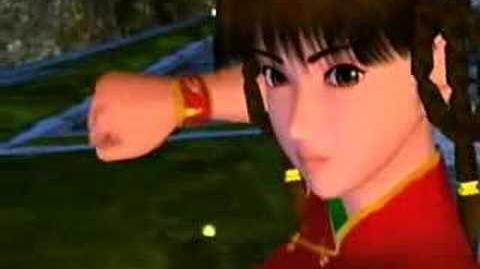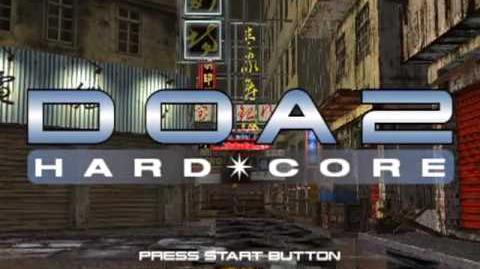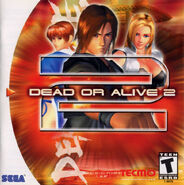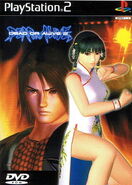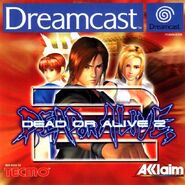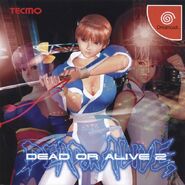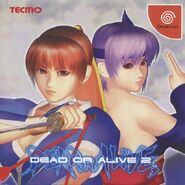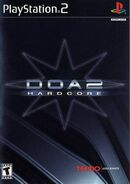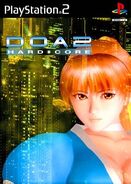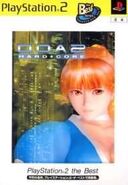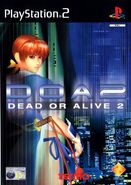Dead or Alive 2 (also known as DOA2) is the second main installment (3rd overall) the Dead or Alive fighting series. It debuted in Japanese arcades in October 1999, and was later released worldwide in 2000 for the Sega Dreamcast. The game was released again in Japan on March 30, 2000 for the PlayStation 2. Later the same year, an updated version of the title, DOA2: Hardcore, was released for the PlayStation 2 across all territories.
On August 22, 2012, DOA2: Hard*Core was made available as a downloadable game on the Japanese PlayStation Network.[1] The North American version was released to the US PlayStation Network on March 24, 2015.
The graphics and gameplay were enhanced from the previous game, and based on a better game engine, which allowed the characters and stages to appear less angular and more detailed. The story involved a narrative continuation of the first game, taking place shortly after the events of Dead or Alive.
Story
A great leader was killed at the end of the 20th century. His name was Fame Douglas, and he was renowned as the sponsor of the legendary Dead or Alive World Combat Championship. Since his death, and in the absence of his charisma and leadership, the world has become chaotic. Yet something appears to be transpiring. Amid this chaos, it is announced that the "Dead or Alive Championship 2" will be held.
However, Douglas' passing has taken with it the purpose and significance of the tournament. Even worse, the promoter of "Dead or Alive Championship 2", who is fond of conflicts and jealous of the strong, is responsible for Douglas's death. The new promoter is more than a corrupt mastermind, but a man of pure evil. His involvement in the tournament has brought a sense of terror to the world, resulting in the infamous tengu disaster that occurred at the end of the 20th century. The climax of the disaster is about to begin with a roaring battle.
Characters
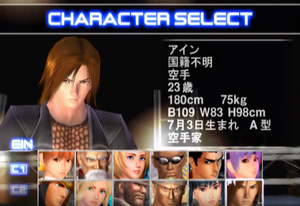
The character selection in the Japanese PlayStation 2 version.
Returning playable characters
- Kasumi, a true-bred kunoichi of the Mugen Tenshin clan. In the previous Dead or Alive tournament, Kasumi defeated her uncle Raidou, the man who severely crippled her older brother, and thus was able to win the tournament. However, this victory came at a price, as Kasumi fell into the evil clutches of a mysterious Super-human Development Project. Before she was able to escape her captivity, the people of the project created a clone from her DNA, Kasumi X.
- Ryu Hayabusa, a super shinobi who has vowed to seek and destroy the evil tengu Bankotsubo. Though a dangerous, suicidal task for any ordinary man, Hayabusa owes it to himself and to mankind to confront his fate.
- Gen Fu, a master of xinyi liuhe quan who despite vowing to never unleash the destructive power of his techniques (especially his legendary attack "Go Ken"), enters the second tournament in desperate need of winning the prize money. Gen Fu must win the money so that he can fund medical research to find the cure for his sick granddaughter's rare disease.
- Tina Armstrong, the current darling in the bitch-slapping world of women's pro-wrestling and the daughter of undefeated wrestling champ, Bass Armstrong. For Tina, victory in the second tournament will push her popularity through the roof.
- Bass Armstrong, the bullish pro-wrestling champion and the over protective father of the beautiful Tina Armstrong. Bass hates the way his daughter uses her sex appeal to gain celebrity status and has entered the second tournament to protect her from getting hurt.
- Zack, a self-taught fighting genius whose muscular strength and unusually funky, kickboxing style grabs the attention of all that witness his fighting. Zack enters the tournament for the one simple reason of winning the prize money.
- Jann Lee, a young master of Jeet Kune Do who fights from the soul. Trained by a renowned master of martial arts, Jann Lee strikes his opponents with his predatory dragon attacks and bird-like cry. Entering the tournament, Jann Lee claims that it is his destiny to succeed.
- Leifang, a t'ai chi quan genius whose ultimate goal is to fight and defeat Jann Lee, the man who was once known to her as a boy named Gi that saved her from a gang of street fighters. Jann Lee's absolute dominance in the combat arena only fuels her challenging spirit.
- Ayane, a stealth kunoichi who is destined to live in the shadow of her older half-sister, Kasumi. Trained in ninjutsu, Ayane's deadly fighting style has earned her the nickname "Female Tengu". She enters the tournament in pursuit of her sister.
New playable characters
- Helena Douglas, the illegitimate daughter of the former DOATEC leader, Fame Douglas, whose recent assassination has pulled Helena into despair. As if that was not bad enough, her mother, while accompanying her daughter on stage at the Opera House, took a bullet meant for Helena. Unsurprising, Helena vowed to seek revenge on the assassin, and while trying to find the culprit discovered that the murder of both her parents is somehow related to DOATEC. Joining the second tournament, Helena is determined to find the assassin.
- Leon, a mercenary soldier who wanders all over the world. His lover Rolande, a thief who worked the Silk Road, died in his arms murmuring "The man I love is the strongest man in the world". In order to fulfill the last words of Rolande, Leon aspires to be the strongest man on earth.
- Ein, a merciless karateka who was left to die in the Black Forest of Germany. Now with serious amnesia, Ein cannot remember his past life and aims to find answers to his self-discovery through participation in the second tournament.
Unlockable characters
- Bayman, the man who assassinated Fame Dogulas in the first Dead or Alive tournament.
- Tengu, also known by his real name Bankotsubo; an evil supernatural being who has entered the human realm to simply create chaos for mankind.
Non-playable characters
- Helena's mother, whose love for her daughter made her take a bullet meant for Helena and end her own life. With Helena now seeking revenge, her mother's unjust death is the main reason why she has entered the tournament.
- Kasumi X, the clone which was created from Kasumi's DNA.
- Rolande, a thief of the Silk Road who died before the second tournament in the arms of her lover, Leon. Her last words were the catalyst for Leon entering the tournament.
Gameplay
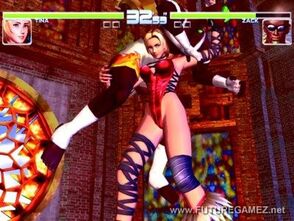
Tina VS Zack in DOA2: Hardcore
The gameplay of Dead or Alive 2, and all subsequent Dead or Alive games, borrows heavily from the Virtua Fighter series, but makes some key changes that drastically changes the way Dead or Alive is played in comparison to Virtua Fighter.
In 'Dead or Alive 2, the basis of the entire fighting system is the circular relationship between three types of moves: holds, throws, and blows. Similar to "rock-scissors-paper", the moves have different actions, and can be stopped by other moves: blows are striking attacks that can be countered by holds; holds are defensive attacks that catch blows and either deals counter damage or parries the attack; and throws are grappling attacks that deal damage to guarding and holding opponents which loses to blows, but catches throws, which don't obey the normal rules.
The other defining feature is a "stun system". In Dead or Alive 2, many attacks, upon hitting, will inflict a "stun" on the opponent. While stunned, the opponent cannot attack, and cannot guard, but they can hold. If the attacker lands a non-knockdown, non-launching attack while the opponent is stunned, the opponent will be re-stunned in a new way, depending on what attack was landed.
A major difference between Dead or Alive 2 and other similar games is in the safety and non-punishability of attacks, both upon hitting and upon being blocked. Most blows in Dead or Alive 2 can be punished on hit and block by each character's faster throws, making blow-based offense very risky.
In Dead or Alive 2, sometimes battles will occur in areas with environmental hazards; walls and falls in the middle of stages are everywhere in Dead or Alive 2. Many stages are also multi-tiered. To get to other areas of the stage, one character must be knocked off a ledge and fall into the next area. These falls deal usually fairly high damage, but cannot knock the opponent out. There are also some walls that are either electrified, or booby-trapped, causing more damage when a character is slammed into a wall by either a knockdown blow, a throw, or a hold.
In addition to the rules of juggling, each character also fits into a specific weight category, which affects how the character responds to being launched and being juggled. The heavier a character is, the lower the character is launched, the less the character bounces up when juggled, the faster the character falls:
- Light Weight Class: Ayane and Kasumi
- Medium Weight Class: Ein, Helena Douglas, Jann Lee, Leifang, Ryu Hayabusa, Tina Armstrong, Zack
- Medium-Heavy Weight Class: Gen Fu
- Heavy Weight Class: Bass Armstrong, Bayman, Leon
- Very Heavy Weight Class: Tengu
Unlocking Characters
Bayman and Tengu are the unlockable characters in the Japanese Dreamcast Dead or Alive 2 and all versions of DOA2: Hardcore. They are playable in every gameplay mode except Story Mode. Tengu can only be unlocked after Bayman.
| Character | Obtained |
|---|---|
| Bayman | SYS1: Clear Story Mode with all characters SYS2: Clear Story Mode 30 times UPS1: Win once with each character UPS2: Play 50 times with UPS on |
| Tengu | SYS1: Collect 10 stars in Survival Mode SYS2: Use any character 200 times UPS1: Play 200 times with UPS on UPS2: None |
Development
Versions
Arcade
The first version of Dead or Alive 2 was released to Japanese arcades on October 19th, 1999, running on Sega's NAOMI arcade system. It featured twelve playable characters, Story Mode and Time Attack Mode. It also included Survival Mode and Tag Battle, but these had to be unlocked with a code in the service menu. An update titled Dead or Alive 2 Millennium was released in January 2000. This made Survival and Tag Battle available from the start and added school uniforms for Kasumi and Ayane. It would be the last arcade release for the series until Dead or Alive 5 Ultimate Arcade thirteen years later.
Dreamcast (NTSC-U)
The Dreamcast port was first released in North America on February 29, 2000. It was identical to the arcade Millennium release, but added the usual Versus and Sparring modes, as well as Team Battle Mode. This version also featured a simpler hold system, which would become standard for the rest of the series:
| Arcade | Console | |
|---|---|---|
| High Punch | ||
| High Kick | ||
| Mid Punch | ||
| Mid Kick | ||
| Low Punch | ||
| Low Kick |
Unlike home ports of the first game, there were no unlockables.
PlayStation 2 (NTSC-J)
Dead or Alive 2 was released on March 30th, 2000 as a launch title for the PlayStation 2 in Japan. This version added new stages (Crimson, Koku An and Prairie) and new unlockable costumes. As it ran at a lower video resolution, it appeared much more aliased than the Dreamcast ports. This version was buggy and prone to lock up in Versus mode.
Dreamcast (PAL)
The European Dreamcast version was released on July 14th, 2000. This version included the costumes from the Japanese PlayStation 2 version but not the new stages. It also added new costumes for Zack and Tina, which pay homage to The Shadow Man and his love interest from the Shadowman series. Acclaim developed the Shadow Man video game and published Dead or Alive 2 in Europe.
Dreamcast (NTSC-J)
The Japanese Dreamcast version (known as the Limited Editon) was released on September 28, 2000. The most notable addition was that Bankotsubo and Bayman were now unlockable, playable in all but Story Mode. The new stages from the PlayStation 2 version were not included, in favor of new versions of Burai Zenin and L's Castle from the first game. This version also added Sparring mode for Tag Battle, Watch Mode, the User Profile System, online play, more costumes to unlock, and a CG Gallery with character renders.
DOA2: Hardcore
Although Dead or Alive 2 was released, Tomonobu Itagaki and Team Ninja were dissatisfied with the then-current versions of the game, and continued enhancing it on both the Sega Dreamcast and PlayStation 2 on each market as they worked towards their vision of the "ultimate fighting game".
On October 25, 2000, Tecmo released a last major update called DOA2: Hardcore for the PlayStation 2, which was based on the Japanese and second update of Dead or Alive 2 for Dreamcast. This version was featuring new playable characters, new stages, extra costumes and introduced the "Gallery" option. The Hardcore release was finally the complete game Itagaki had envisioned at the time, featuring many changes compared to its predecessor:
- Characters, pictures and moves were altered to appear more realistic, lessening the anime-look.
- Some fighting animations were elaborated upon and some were cut.
- New stages were added (8 more than the Dreamcast update)
- More character outfits were added.
- Survival Mode now only took place in the "Danger Zone" arena.
- Overall gameplay speed was increased. The entire game, including cutscenes, now runs at a full 60 frames-per-second (In the Dreamcast version, the game ran at 60 fps, while the cutscenes ran at 30).
- A special "Items Collection" feature and menu section was added to appeal to video game collectors. New artworks were added compared to the first update.
- A CG Gallery section, featuring renders of the female characters, was added.
- The player history files were enhanced, and now included statistics on how often the player used each character, and tag battle pairing.
- Several special moves were added, but left undocumented.
- English voiceovers were added in the U.S. PlayStation 2 version, in addition to the original Japanese voice overs.
The new release extended the success of Dead or Alive 2 in North America and Western Europe, and Dead or Alive became Tecmo's flagship series. Tecmo also followed up on the release of Hardcore in the USA and Europe with the release of DOA2: Hard*Core in Japan. This last version saw some minor updates, including new cutscenes, a few new costumes, and a new turbo speed option.
As a result, nine different versions (excluding the later Dead or Alive 2 Ultimate on Xbox and the two more recent PSN releases) of Dead or Alive 2 were released: two for the arcade market, and the others were home versions. Unfortunately, even with all the changes, Itagaki was still not happy with Dead or Alive 2. He is quoted as saying in the Dead or Alive 3 booster disc video: "They wanted a launch title in 3 months. I needed 4."
On August 22, 2012, DOA2: Hard*Core was made available as a downloadable "PS2 Classic" on the Japanese PlayStation Network. The title is classed an age rating of C and costs 1,500 yen. This game is also now available on the Hong Kong PlayStation Network. The North American version was released to the US PlayStation Network on March 24, 2015.
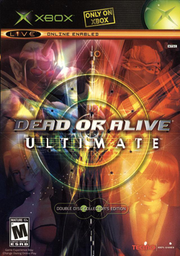
The cover of Dead or Alive Ultimate
Dead or Alive 2 Ultimate
Dead or Alive Ultimate is a remake compilation collection for the Xbox, featuring a port of the Sega Saturn version of the first Dead or Alive and a new remake of Dead or Alive 2, released in 2004, three years after the release of Dead or Alive 3.
This new remake features a greatly improved graphics engine. As it was created after the debut of Dead or Alive 3, it takes elements and mechanics from both its original iteration and successor. The action of 3D-axis movement is as free-formatted as Dead or Alive 3, and a new character from Dead or Alive 3, Hitomi was placed in the game as a unlockable playable character outside Story Mode.
The biggest set of changes instituted in Dead or Alive Ultimate are online play over Xbox Live, and the inclusion of slopes, which are a type of environmental hazard.
Production credits
Notes:
1 The characters (with their voice actors) were not listed in the in-game credits.
2 The voice actors were not listed next to their characters in the in-game credits.
Arcade credits
| Staff credits | |
|---|---|
| Producer & Director | Tomonobu Itagaki |
| Chief Designer | Hiroaki Matsui |
| Lead Programmers | Hiroaki Ozawa, Yasushi Maeda |
| Game System Designer | Katsunori Ehara |
| Motion Manager | Makoto Isomine |
| Motion Design Director | Hideki Saito |
| Assistant CG Manager | Hideyuki Kato |
| Character Modeling | Yasushi Nakakura |
| Character Texture | Muneaki Kubota |
| Stage Design Director | Hideyuki Takita |
| Sound Composer | Makoto Hosoi |
| CG Effects | Yasuo Egawa |
| Programmers | Takeshi Kawaguchi, Takeshi Sawatari, Mitsuo Osada, Tetsuya Imamura, Kazuhiro Kosuge, Takashi Watanabe, Junichi Ueno, Tomonobu Kinugasa, Takuro Sasaki |
| Planners | Takayuki Asami, Yuko Sasaki, Mizuki Takeda, Hiroyasu Itakura |
| Motion Designers | Chitose Sasaki, Toru Mishima, Jitsuo Kondo, Masanori Sato, Akira Izumi, Masaki Koshikawa, Yuki Naruse, Tomoo Hiraoka, Shigefumi Ishizuka, Osamu Honma, Ryuji Ikeda, Taro Matsushita, Yukiyoshi Amano, Takuji Otsuka, Koji Motoume |
| Motion Script | Noriaki Kazama, Sousuke Sameshima |
| Character Modeling | Yoshiki Horiuchi, Haruhiko Shikata |
| Character Texture | Hideaki Takahashi, Atsushi Saito |
| Stage Designers | Hideki Niimi, Yusuke Iida, Takayuki Ebata, Kenichiro Nakajo, Katsuhiro Mukasa |
| Sound Composers | Shigekiyo Okuda, Syouichi Koike |
| Realtime Movie Script | Yukihiro Fujita, Shigeaki Ota, Junichi Araki |
| Voice Actors (affiliated with Aoni Production) | |
| Kasumi | Sakura Tange |
| Gen Fu | Takeshi Aono |
| Tina Armstrong | Yūko Nagashima |
| Zack | Bin Shimada |
| Jann Lee | Toshio Furukawa |
| Ayane | Wakana Yamazaki |
| Ryu Hayabusa | Hideyuki Hori |
| Helena Douglas | Yuka Koyama |
| Bass Armstrong | Daisuke Gōri |
| Leon | Kōji Totani |
| Leifang | Yumi Tōma |
| Ein | Hikaru Midorikawa |
| Tengu (Bankotsubo) | Osamu Saka |
| Rolande | Yuka Koyama |
| System Voice | Miyako Endō |
| Kasumi X1 | Sakura Tange |
| Staff credits (part 2) | |
| Motion Actors | Miho Iijima, Mako Kogiso, Japan Action Club (Tsutomu Kitagawa, Yoichi Nishimura, Jiro Okamoto) |
| Test Players | Yasuaki Sakaguchi, Kenji Takemori, Takahiro Tomiya, Naoaki Niisaka, Yuji Hinoto |
| Special Thanks | Naomi Lib Team (Rikiya Nakagawa, Tatsuya Watanabe, Ichiro Kawaoka, Teruhito Abe, Koji Ohto) |
| Publicity | Koji Harao |
| Marketing Executive | Satoshi Kanematsu |
| Executive Producer | Max Naka |
| Presented by Tecmo Ltd. Team Ninja 1999 - 2000 | |
Dreamcast credits
| Staff credits | |
|---|---|
| Producer & Director | Tomonobu Itagaki |
| Planner | Hiroaki Matsui |
| Lead Programmer | Takeshi Kawaguchi |
| Game System Designer | Katsunori Ehara |
| Motion Managers | Noriaki Kazama, Chitose Sasaki |
| Motion Design Director | Masaki Koshikawa |
| Assistant CG Manager | Hideyuki Kato |
| Character Modeling | Yasushi Nakakura |
| Character Texture | Muneaki Kubota |
| Stage Design Director | Hideyuki Takita |
| Sound Composers | Makoto Hosoi, Shigekiyo Okuda |
| CG Effect Designer | Yasuo Egawa |
| Programmers | Yasushi Maeda, Hiroaki Ozawa, Takeshi Sawatari, Junichi Araki, Shigeaki Ota, Mitsuo Osada, Kazuhiro Kosuge, Tetsuya Imamura, Takashi Watanabe, Taiyo Aramaki, Naoyuki Ohashi, Junichi Ueno, Tomonobu Kinugasa, Takuro Sasaki |
| Planners | Masanori Sato, Yukiyoshi Amano, Motohiro Shiga, Hiroyasu Itakura |
| Motion Designers | Jitsuo Kondo, Hideki Sato, Yuki Naruse, Tomoo Hiraoka, Shigefumi Ishizuka, Ryuji Ikeda, Taro Matsushita, Takuji Otsuka, Koji Motoume |
| Motion Script | Sousuke Sameshima |
| Character Modeling | Yoshiki Horiuchi, Haruhiko Shikata |
| Character Texture | Hideaki Takahashi |
| Stage Designers | Hideki Niimi, Akira Izumi, Takayuki Ebata, Kenichiro Nakajo, Katsuhiro Mukasa |
| Realtime Movie Script | Yukihiro Fujita |
| Voice Actors (affiliated with Aoni Production) | |
| Kasumi | Sakura Tange |
| Gen Fu | Takeshi Aono |
| Tina Armstrong | Yūko Nagashima |
| Zack | Bin Shimada |
| Jann Lee | Toshio Furukawa |
| Ayane | Wakana Yamazaki |
| Ryu Hayabusa | Hideyuki Hori |
| Helena Douglas | Yuka Koyama |
| Bass Armstrong | Daisuke Gōri |
| Leon | Kōji Totani |
| Leifang | Yumi Tōma |
| Ein | Hikaru Midorikawa |
| Tengu (Bankotsubo) | Osamu Saka |
| Rolande | Yuka Koyama |
| System Voice | Miyako Endō |
| Kasumi X1 | Sakura Tange |
| Staff credits (part 2) | |
| Motion Actors | Miho Iijima, Mako Kogiso, Japan Action Club (Tsutomu Kitagawa, Yoichi Nishimura, Jiro Okamoto) |
| Translator | Hsiang-Lan Lee |
| Publicity | Mitsuru Tsutsumi, Koji Harao |
| Marketing Executives | Isamu Fukada, Kazumi Fujita, Satoshi Kanematsu |
| Executive Producer | Max Naka |
| Presented by Tecmo Ltd. Team Ninja 2000 | |
DOA2: Hardcore credits
| Staff credits | |
|---|---|
| Producer & Director | Tomonobu Itagaki |
| Project Manager | Yasushi Maeda |
| Planner | Hiroaki Matsui |
| Lead Programmers | Takeshi Kawaguchi, Hiroaki Ozawa |
| Game System Designer | Katsunori Ehara |
| Motion Managers | Noriaki Kazama, Chitose Sasaki |
| Motion Design Director | Masaki Koshikawa |
| Assistant CG Manager | Hideyuki Kato |
| Character Modeling | Yasushi Nakakura |
| Character Texture | Muneaki Kubota |
| Sound Composer | Makoto Hosoi |
| CG Effects Designer | Yasuo Egawa |
| Programmers | Takeshi Sawatari, Junichi Araki, Mitsuo Osada, Tetsuya Imamura, Kazuhiro Kosuge, Takashi Watanabe, Taiyo Aramaki, Naoyuki Ohashi, Junichi Ueno, Tomonobu Kinugasa, Takuro Sasaki, Nobuhiro Oda, Kei Shinohara |
| Planners | Masanori Sato, Motohiro Shiga, Hiroyasu Itakura |
| Motion Designers | Jitsu Kondo, Hideki Sato, Yuki Naruse, Tomoo Hiraoka, Shigefumi Ishizuka, Ryuji Ikeda, Taro Matsushita, Takuji Otsuka, Koji Motoume |
| Motion Script | Sousuke Sameshima |
| Character Modeling | Yoshiki Horiuchi, Haruhiko Shikata |
| Character Texture | Hideaki Takahashi |
| Stage Designers | Hideki Niimi, Akira Izumi, Takayuki Ebata, Kenichiro Nakajo, Katsuhiro Mukasa, Hideaki Kato, Junichi Ikeya |
| Realtime Movie Script | Yukihiro Fujita, Masato Onishi |
| Japanese Voice Actors (affiliated with Aoni Production) | |
| Kasumi | Sakura Tange |
| Gen Fu | Takeshi Aono |
| Tina Armstrong | Yūko Nagashima |
| Zack | Bin Shimada |
| Jann Lee | Toshio Furukawa |
| Ayane | Wakana Yamazaki |
| Ryu Hayabusa | Hideyuki Hori |
| Helena Douglas | Yuka Koyama |
| Bass Armstrong | Daisuke Gōri |
| Leon | Kōji Totani |
| Leifang | Yumi Tōma |
| Ein | Hikaru Midorikawa |
| Tengu (Bankotsubo) | Osamu Saka |
| Rolande | Yuka Koyama |
| System Voice | Miyako Endō |
| Bayman1 | Banjō Ginga |
| Kasumi X1 | Sakura Tange |
| Staff credits (part 2) | |
| Buto Kenpo Kyokai | Feng Zheng Bao, Taisuke Kitamura |
| Kaimon Kensya | Tetsuya Hattori |
| Kouka Kokujutsu Syudokai | Shigeki Ooki |
| Motion Actors | Miho Iijima, Mako Kogiso, Japan Action Club (Tsutomu Kitagawa, Yoichi Nishimura, Jiro Okamoto) |
| Artwork Designers | Takashi Miyamae |
| Publicity | Kazumi Fujita, Teruaki Ichikawa, Satoshi Kanno |
| Marketing Executives | Satoshi Kanematsu, Toru Akutsu, Juntaro Kono |
| English Voices (produced by Berkeley Sound Artists) | |
| Casting Directors | James LeBrecht, Patti Tauscher |
| Director | James LeBrecht |
| Editor | Rob Liam |
| Recording Facilities | Fantasy Studios, Berkeley, California |
| Recoring Engineers | Frank Rinella, Stephen Hart |
| English Voice Actors2 | |
| Kasumi | Lucy Kee |
| Gen Fu | Roger L. Jackson |
| Tina Armstrong | Sally Dana |
| Zack | Brian Vouglas |
| Jann Lee | Brian Vouglas |
| Ayane | Gina DeVettori |
| Ryu Hayabusa | John Parsons |
| Helena Douglas | Zoe Galvez |
| Bass Armstrong | Terry McGovern |
| Leon | Timothy Enos |
| Leifang | Donna Mae Wong |
| Ein | Jeremy Hou |
| Tengu (Bankotsubo) | Timothy Enos |
| Rolande | Zoe Galvez |
| Bayman | Timothy Enos |
| Kasumi X | Donna Mae Wong |
| Staff credits (part 3) | |
| Executive Producer | Max Naka |
| Presented by Tecmo Ltd. Team Ninja 2000 | |
DOA2: Hard*Core extended credits
| Project manager | Yasushi Maeda |
| Planner | Hiroaki Matsui |
| Lead programmer | Takeshi Kawaguchi, Hiroaki Ozawa |
| Game system designer | Katsunori Ehara |
| Motion managers | Noriaki Kazama, Chitose Sasaki |
| Motion design director | Masaki Koshikawa |
| Assistant CG manager | Hideyuki Kato |
| Character modelling | Yasushi Nakakura |
| Character texture | Muneaki Kubota |
| Stage design director | Hideyuki Takita |
| Sound composer | Makoto Hosoi |
| CG effect designer | Yasuo Egawa |
| Programmers | Takeshi Sawatari, Junichi Araki, Mitsuo Osada, Tetsuya Imamura, Kazuhiro Kosuge, Takashi Watanabe, Taiyo Aramaki, Naoyuki Ohashi, Junichi Ueno, Tomonobu Kinugasa, Takuro Sasaki, Nobuhiro Oda, Kei Shinohara |
| Planners | Masanori Sato, Motohiro Shiga, Hiroyasu Itakura |
| Motion designers | Jitsu Kondo, Hideki Sato, Yuki Naruse, Tomoo Hiraoka, Shigefumi Ishizuka, Ryuji Ikeda, Taro Matsushita, Takuji Otsuka, Koji Motoume |
| Motion script | Sousuke Sameshima |
| Character modelling | Yoshiki Horiuchi, Haruhiko Shikata |
| Character texture | Hideki Takahashi |
| Stage designers | Hideki Niimi, Akira Izumi, Takayuki Ebata, Kenichiro Nakajo, Katsuhiro Mukasa, Hideaki Kato, Junichi Ikeya, Naoki Ieda |
| Realtime movie script | Yukihiro Fujita, Masato Onishi |
| Artwork designers | Takashi Miyamae |
| Publicity | Kazumi Fujita, Teruaki Ichikawa, Satoshi Kanno |
| Marketing executive | Satoshi Kanematsu, Teru Akutsu, Juntaro Kono |
| Producer & Director | Tomonobu Itagaki |
| Executive producer | Max Naka |
Reception
In 2010, the game was included in the list of "Top 25 Fighting Games of All Time" by UGO
Videos
Packaging artwork
Dead or Alive 2 versions
DOA2: Hardcore versions
See also
- Costumes
- Command lists
- Fighting quotes
- Item Collection Datasheet
- Merchandise
- Dead or Alive 2 Original Sound Trax
- Dead or Alive 2 Original Sound Trax ~PlayStation 2 Version~
- Promotional Artwork and Wallpapers
Trivia
- Suezo, a recurring monster in the Monster Rancher series, appears as a collectible item in Survival Mode.
- Kasumi is unlocked as a trainable monster in Monster Rancher 4 by going to the Shrine, and inserting the DOA2: Hardcore disk in the PlayStation 2 Disc Tray.
- A popular and commonly discussed feature, one credited to Itagaki, was the level of graphical detail Tecmo put into the animated breasts of the female characters, as Tecmo went so far as to create a physics engine dedicated entirely to the animation of the female characters' breasts.
- It was the last Dead or Alive game to be released for a Sony system as the series became exclusive for the Xbox, until the release of Dead or Alive Paradise, and Dead or Alive 5.
- Dead or Alive 2 was the only game that Tecmo published to be playable on the Dreamcast.
- In the opening cinematics Ayane uses an energy blast on a downed Kasumi. This can be achieved in Ayane's Story Mode by getting Kasumi to fall into the chasm (or by making the field crumble) and having Ayane at least 15 ft away from Kasumi when the end cinematic starts. It is speculated that this (Ninpo) technique is capable of killing the target, meaning that in Ayane's storyline she succeeded in killing Kasumi. This was proven false in Dead or Alive Dimensions as Kasumi teleported away before she could get hit, causing Ayane to miss her shot completely.
- DOA2: Hardcore is briefly seen in the 2002 film One Hour Photo. In the scene, the son Jake Yorkin (portrayed by Dylan Smith) is playing the game in his bedroom, and on the television screen is Leifang and Jann Lee fighting in the Aerial Gardens.
References
External Links
- Official website (Japanese PlayStation 2)
- Official website (Japanese Dreamcast)
- Official website (European PlayStation 2)
- Official website (Japanese Hard*Core)
- Comparison between versions (archive.org)
- Wikipedia: Dead or Alive 2


